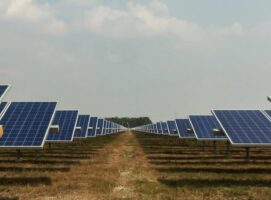Edinburgh-based global sustainable energy company Simec Atlantis announced Monday that it had completed the installation of mammoth tidal stream turbine, boasting a rotor diameter of 18 metres, in the Zhoushan archipelago in China.
What makes this feat even more incredible is the fact that the turbine was manufactured in Wuhan, China, epicentre for the global COVID-19 pandemic.
Simec Atlantis, working with The China Shipbuilding Industry Corporation (CSIC) and China Three Gorges (CTG), completed the development of CTG’s first 500kW tidal stream turbine between the islands of Putuoshan and Huludao in the Zhoushan archipelago.
Deployment of the “mammoth” tidal stream turbine – with an impressive 18 metre rotor diameter – is an important step on the way to prising open China’s tidal stream potential, which could theoretically supply more than 8.2GW of the country’s power, according to a 2015 analysis.
“Atlantis can be extremely proud of the role we played in this project,” said Tim Cornelius, Chief Executive of Simec Atlantis Energy. “The fast execution, from concept design to installation, represents a phenomenal feat of engineering that bodes well for a rapid future roll-out of tidal power in China, which in turn will have material cost reduction implications globally.”
Simec Atlantis, founded in Australia, is one of the world’s leading marine-based renewable energy developers and currently has a diverse portfolio of projects in various stages of development.
Prime amongst the company’s achievements is its 77% stake in the world’s largest tidal stream power project, the 6MW MeyGen tidal stream project located in Scotland’s Pentland Firth. The project is only a pilot demonstration on its way to expanding to 86MW, with construction currently underway.
Even before its expansion is completed, however, MeyGen was setting records, generating 13.8GWh of electricity in 2019 – the equivalent of the average annual consumption of around 3,800 UK households.
The MeyGen project has also served as SIMEC Atlantis’ stepping stone to exporting its operational expertise and technology to the world, including projects in Normandy in France, Indonesia, and Japan.
“MeyGen has demonstrated the true potential of tidal energy and has de-risked the market to the extent that we are now exporting knowhow and equipment internationally, with China the latest market to open in Asia,” added Cornelius.
The company is also the sole owner of the 220MW Uskmouth power station conversion project – a world first conversion project intended to convert a coal-fired power plant to generate electricity from waste-derived fuel pellets.
But as big as the newly completed tidal stream turbine for CTG’s 500kW tidal stream, it still falls short of SIMEC Atlantis’ upcoming AR2000. Announced back in September of 2018 and partnering with General Electric’s Power Conversion business, the new AR2000 tidal stream turbine will boast generating capacity of 2MW and a rotor diameter somewhere between 20 and 24 metres (depending on site requirements).
“The AR2000 marks the culmination of 15 years of investment, relentless experimentation, rigorous testing and subsea operation,” said Drew Blaxland, Director of Turbine and Engineering Services back in 2018. “Not only will it be the largest single rotor turbine in production, it will be the backbone of a highly efficient and cost-effective generation system capable of deployment in each of our key target markets in the UK, France, Channel Islands, Asia, Australia and Canada.
“The AR2000 draws on lessons learned during more than 13,000 hours of operation of the Marine Current Turbines SeaGen turbine in Northern Ireland and 4,000 operational hours of the AR1500 in Scotland. The AR2000 will enable multi-turbine connection onto a single power export cable to reduce cost and its larger rotor diameter will deliver greater efficiencies over a range of flow regimes.
“The AR2000 system has been designed to deliver a lower levelised cost of energy and increased reliability,” Blaxland added. “Combining a larger rotor diameter with a drive train capable of being daisy-chain linked, optimised redundancy and quick connection, will deliver an offshore generation system that can compete with other comparable sources of renewable generation when deployed at scale.”










